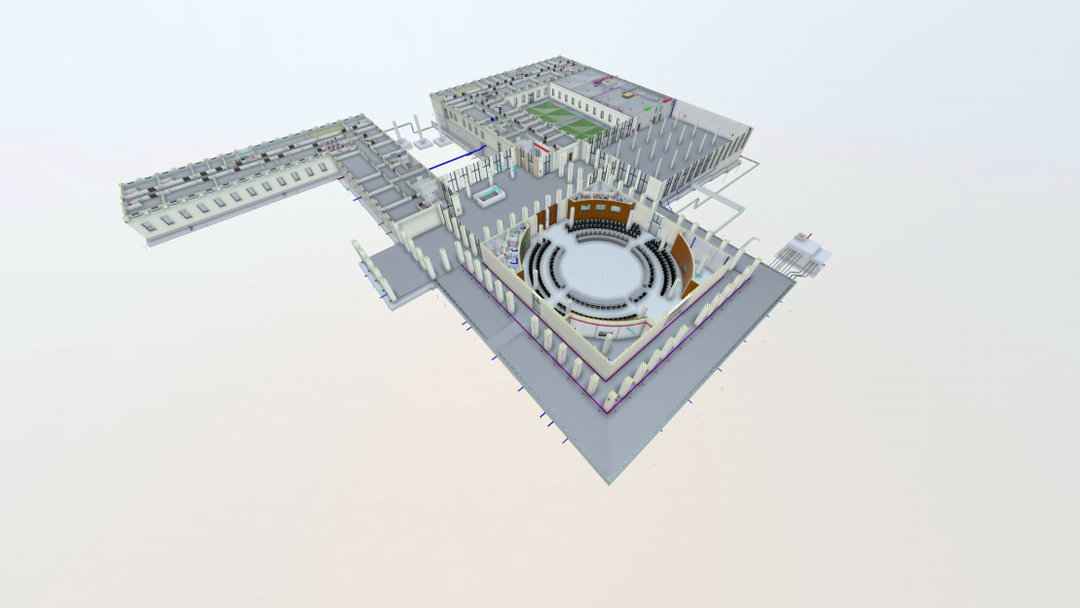Julius Berger and its subsidiaries are driven by excellence. Highlighted by the group’s high quality standards as well as participation in innovative technologies and developments within the construction industry. The current proven technology within this economy by far is “Building Information Modelling” (BIM) – a shared knowledge resource that is the foundation of the digital transformation of the design and construction industry. Within the Julius Berger Group we are on the pulse of BIM developments and are working closely with universities and market pioneers to gain continuous knowhow.
Application of BIM enables the development of new tools and processes during the engineering, procurement, construction, and installation project phases, based on the possibilities the software provides.
Reaping the Benefits of BIM
The most significant benefits of introducing BIM methodology on projects is the greater efficiency and transparency it brings to the process. With BIM, decisions traditionally made late in the project are shifted to the earlier stages of the design, when it is still possible to amend design with minor negative impacts on the overall process but major positive impact on the time and cost of the entire project. BIM is unique as it not only reflects the three dimensions of the design (length, width, height) into one model, but also incorporate time as a fourth dimension and the cost as a fifth dimension. This 5-dimentional model is described as a 5D BIM Model, considered to be a state-of-the-art approach for complex and high-profile construction projects worldwide.
With BIM, the possibility for the project architects, designers, engineers, and other parties to work according to one single source of truth leads to improved design and data consistency compared to traditional approaches. This results in greater overall efficiency, including time savings and stronger coordination during the different phases of a construction project.
BIM in Action
Adopting innovative approaches supports the continuous improvement of our group’s design and construction processes, but the greatest benefit is the value it provides to clients. One of our most recent projects was a BIM lighthouse project: the New Headquarters of the Office of The National Security Adviser (ONSA) in ABUJA - a new four-story high headquarter with more than 15,000 m2 Gross Floor Area. This project was a perfect fit for the application of BIM technology, to bring the specializations and scope of our group and project trades together in one combined model. Julius Berger’s scope comprised the design and construction of the headquarter, including a conference hall, partial basement, ancillary buildings, and landscaped areas.
BIM Project
To include our client in the project process and deliver maximum transparency, Julius Berger used the 5D BIM approach for this project. For example, during the material review meetings it was possible for the client to use virtual reality tools to walk through the project prior to the start of construction works. The model was even fitted out with furniture, provided by our furniture production factory, AFP, so that the fit out could be digitally reviewed in its entirety prior to install by the client. This transparency and efficiency was applied to every stage, here is a simplified breakdown of the process:
Architectural design:
We worked with several Architect, Engineers and Draftsmen to create an architectural Model based on our own content. This content contains information necessary for checking, linking, visualizing, analyzing, and assessing all data of our model.
Automated connection of the model elements to the projects Bill of Quantities ensured quantities remained up to date and in line with the tender documents. Within this step it was even possible to compare and control the quantities with a visual reference of the project. No part of the building could be forgotten because every item modeled had to be connected to an item on the Bill of Quantities.
MEP design:
The MEP design was prepared by an external partner. The MEP model was closely linked to the Julius Berger model and therefore all necessary openings could be coordinated and potential collisions between the different trades could be detected early on and managed accordingly.
Structural Design:
Our structural design team was the most experienced in implementing BIM Modeling. Almost all elements modeled were already preconfigured and taken from our in-house library of BIM objects and could therefore be evaluated for further processing.
Infrastructure Design – implementation of external design:
The site layout surrounding the building was also modeled to ensure the best solutions for interfaces between building and infrastructure. Suppliers for technical equipment were able to contribute detailed modeled machinery and ductwork so potential clashes could already be detected before delivering material to site.
Time Schedule:
Based on the model created by the different parties and the resulting certainty of quantities, we were able to create a work preparation and time schedule connected with the BIM Model, strengthening project management to ensure the clients milestones were met on-time. In addition to the client’s benefit of a fixed timeline, it was also possible to connect the digital time schedule with the BIM model and create a real prognosis of the progress on site including visualization/simulation of the different steps.
Cost / Estimation / Controlling:
The created time schedule connected with the BIM model allowed us to prepare much more detailed forecasts for material needs on site, therefore optimizing the work preparation and resulting in less standstills or delays on site due to a secured material flow.
On site tools:
The steps before installation are only a part of the project life cycle, hence the benefits of BIM should be reflected in further stages. The BIM model was used on site to review detailed designs of critical areas of the building and the team on site benefitted from the information availability of this detailed information. Using augmented reality tools, it was even possible to compare the designed model with the construction works on site and detect potential issues without extensive effort.
Outlook
The design and construction of this headquarter building has proven the known benefits of BIM. Through this project our subsidiaries Julius Berger International and Primetech Design and Engineering Nigeria took greater steps forward in developing Julius Berger’s BIM Knowledge.
Looking forward, BIM is our standard. Every design project will be a BIM project (level depending on requirements). This enables our national and international partners to work more closely together and increases the quality and efficiency for all parties, especially the client in the end. Further tests have already shown that even external designs for façade works could be implemented into BIM project models. Therefore, we also look forward to our next group building project, to also incorporate the façade information created by our subsidiary Abumet Nigeria Limited, in order to innovatively deliver to our client’s full satisfaction.
Expanding dimensions is the future, and at Julius Berger we continue to find ways to improve. Next up - investigate the possibilities to include sustainability analysis (6D) and facility management applications (7D) to create projects even more suitable for the 21st century.
Find out more about BIM here: buildingSMART - The International Home of BIM


